
Rural Water Supply in Nepal: Concrete Course[edit | edit source]
Technical Training Manual No. 3
Published by:
Local Development Department, Ministry of Home
and Panchayat, Government of Nepal/
Swiss Association for Technical Assistance/
United Nations Children's Fund
Kathmandu, Nepal
Available from:
United Nations Children's Fund
Lazimpat
P.O. Box 1187
Kathmandu
Nepal
Reproduced by permission of UNICEF/Nepal.
Reproduction of this microfiche document in any
form is subject to the same restrictions as those
of the original document.
TRAINING MANUAL no. 3
CONCRETE COURSE;
Prepared and Published by
Local Development Department, Ministry of Home and Panchayat
SATA - Swiss Associationn for Technical Assistance
UNICEF - United Nations Children's Fund
Kathmandu 1977
CONCRETE COURSE[edit | edit source]
1. General
1.1 Definition
Concrete is a mixture of:
- aggregates ( sand, gravel)
- adhesive ( cement )
- water
1.2 Types of concrete
There are many types of concrete which can be grouped,
for example, according to the raw materials or to the
quality.
For our purpose we can seperate three different types
of concrete, according to their use:
- lean concrete
- non-reinforced concrete
- reinforced concrete
As non-reinforced and reinforced concrete have the same
mixture of aggregates, cement and water, the difference
is explained as follows:
Concrete alone has a very high compression strength
but a low tensile strength. So concrete which is
exposed to tensile stresses has to be strengthened
with steelbars, These have a very high tensile
strength.
Take for example a slab of a spring collection chamber-

Due to dead load and additional loads such as people,
earthfill, snow etc. the slab will get tensile stresses
at the bottom. So in this place we must put some steelbars
into the concrete.
The number, diameter, length and position of the bars
is a matter for the design engineer or the engineer -
in - charge of the project.
1.3 Application of concrete
I. Lean concrete: To make a clean and completely
horizontal base for concrete and
masonry constructions.
1. Example : Storage tank wall - foundation.
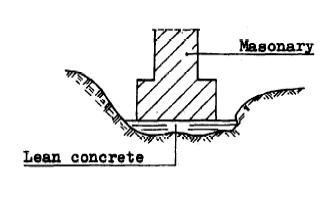 2. Example: Foundation of a ,spring collection chamber.
2. Example: Foundation of a ,spring collection chamber.
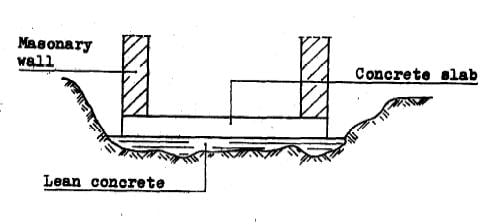 II. Non-reinforced concrete: ,- To make foundations, floors
small staircases, walls etc.
All concrete constructions
which are not exposed to
high tensile stresses.
II. Non-reinforced concrete: ,- To make foundations, floors
small staircases, walls etc.
All concrete constructions
which are not exposed to
high tensile stresses.
Example: Floor of a storage tank
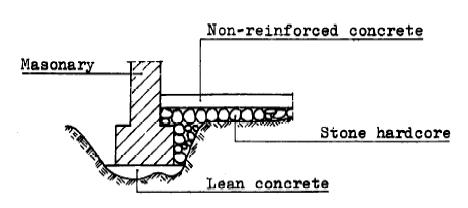
III. Reinforced concrete: To make all kind of concrete
constructions such as slabs,
walls, bridges, etc.
Example: Slab of a spring collection chamber
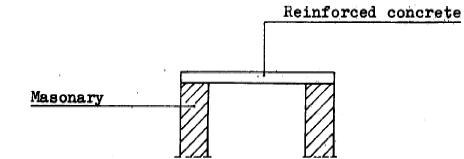 Note: The decision to use reinforced or non-reinforced
concrete is a matter for the engineer,and it should
be shown on the site drawings.
Note: The decision to use reinforced or non-reinforced
concrete is a matter for the engineer,and it should
be shown on the site drawings.
2. Materials[edit | edit source]
2.1 The aggregates
2.1.1 Origin and extraction
Natural materials
Rubble sediments in rivers and lakes. Due to long
transport in the rivers, gravel and sand are
ground round,and bad materials have already been
eliminated. They are also washed’s0 that in many
cases they are ready to be used <for making concrete.
Crushed materials
Pieces of rocks, and big stones broken in stone
breakers or by hand.
This material must be washed and sorted out. It
is important to remove all the dust which arises
by crushing; stone with cracks should be eliminated.
To obtain a high strength the crushed material
should be mixed with river sand.
2.1.2 The form of grains
The compressive strength of each grain must be
higher than the strength of the finished concrete.
The ideal form of gravel is round for river gravel
and cubic for crushed gravel. Do not use weatherworn
stones,slate and flat stones.
2.1.3 Impurities
If aggregates are dirty and contain grass leaves,
wood, humus, silt, clay etc, they have to be
washed, but particular attention should be paid
not to wash away the fine sand aggregates. Gravel
and sand containing impurities cause heavy loss of
strength in the finished concrete.
Simple methods for field tests:
Fist test:
The hand filled with the aggregates to be tested
is to clench and then to open again. If the
material is clean it should not stick together
in a lump. When the material is rubbed between
the hands, they should remain almost clean.
Bottle test:
A clear bottle filled up to 2/3 with material and
the remaining space with water is to be shaked
vigorously. After about 30 minutes of settlement,
there should be no dirt or silt on top of the material.
2.1.4 Grading or gradation
In properly made concrete, each particle of aggregate
is completely surrounded by cement paste. The better
the distribution of the particle"sizes, the better all
spaces will be filled and the denser and stronger the
finished concrete will be.
 The most common composition is 3 parts gravel and
2 parts sand.
The most common composition is 3 parts gravel and
2 parts sand.
To find out the proper composition, it is recommended
to make testing mixtures on site. The following table
should give an idea of a good gradation.
Table of gradation:
| Range of grains | |||||
|---|---|---|---|---|---|
| mm | 0-8 | 0-15 | 0-30 | 0-60 | |
| Dust | 0.0-0.1 | 8-14 | 5-10 | 3-7 | 2-5 |
| Fine Sand | 0.1-1 | 15-21 | 16-15 | 7-11 | 5-7 |
| Medium Sand | 1-4 | 38-37 | 23-26 | 13-18 | 9-14 |
| Coarse sand | 4-8 | 39-28 | 24-21 | 16-15 | 9-10 |
| Fine gravel | 8-15 | 37-28 | 21-19 | 13-14 | |
| Medium gravel | 15-30 | 40-30 | 22-20 | ||
| Coarse gravel | 30-60 | 40-30 |
2.2 Cement
2.2.1 Introduction
Cement is a product of minerals which are burnt
and then pulverized. If water is added it becomes
a binding paste which first sets (becomes firm)
ard then hardens for an indefinite period. The
setting and hardening are brought about by chemical
reaction between the cement and the water. This
process is called hydration.
On the world market there are a lot of different
adhesives available. But in Nepal, and also in
other countries, only portland cement is used
to date. Therefore the following chapters give
a brief description of this portland cement.
2.2.2 Manufacture
The raw materials, limestone and clay, are extracted
from quarries and crushed into pieces
of the size of a fist. After this, the raw
materials are mixed with hydraulic compound,
granulated and burnt at a temperature of 15OOOC.
This burning produces a clinker which is cooled
and pulverized into fine powder with a small
amount of gypsum added to regulate the setting
time. This powder is the finished portland
cement.
2.2.3 Hydration
Hydration of the cement is divided into two
processes: The setting stage and the hardening
stage.
Setting:
This chemical process which radiates heat, starts
at a certain time after the water has been added
and it lasts till the mass is solid. The time of
beginning and the duration of this process
varies mainly according to the temperature. At
a temperature of 180C the setting starts after
about 2.5 hours and lasts 7 hours. If the temperature
falls to O°C, no setting process takes
place. In the tropics, where temperatures of
30°C often occur, the same cement may change to
a quick setting one.
During the setting time the material must not be
disturbed, 2s this would diminish its strength
considerably.
The setting time can be checked on site, by a very
simple method :
The concrete is scratched with a
fingernail or 2 piece of soft wood.
If it flows together again, the setting has not
yet started, if the scratch remains, the setting
is in process, if no scratch can be seen on the
concrete, the setting stage has finished and the
hardening stage has already started.
Hardening:
Theoretically portland cement never stops hardening
and therefore the end of the process cannot really
be determined.
For practical work it is sufficient to know how
long it takes a structural part to attain the
required strength.
2.2.4 Shrinkage
All adhesives, including portland cement, are subject
to shrinking during the setting and the hardening
process.
The shrinkage must be counteracted by keeping the
mortar or the concrete wet.
2.2.5 Storage of cement
Cement should not be stored longer than three months.
Otherwise the strength will be reduced to approximately
75% of the original value. If cement is
allowed to absorb any moisture, it will set more
slowly and the strength will be drastically in
decreased.
In storing cement, especially sacked cement, the
warehouse or shed should be as airtight as possible.
All cracks in the roof and walls must be closed.
The floor should be above ground to protect cement
against dampness. Sacks should be stored close
together to reduce the circulation of air, but at
least 50 cm away from walls, and with not more than
10 bags per pile.
On smaller sites, where there is no shed or other
building available, the sacks may be placed on
a raised wood platform. A waterproof tarpauline
should be placed over the pile to protect the cement
against rain. The tarpaulin should extend over
the edges of the platform. If the cement is hard
due to moisture, it can not be used.
2.3 Water
The water must b:e clean. Drinking water is always suitable
for making concrete. If it is not possible. to use drinking
water it must be certain that the water is not polluted by:
- soil particles
- mud
- dirt
- oil
- soap, etc
It is important to use only clean water for making concrete
and mortar.
3. Making and handling of concrete[edit | edit source]
3.1 Mixture
3.1.1 The amount of aggregates
Experiments have shown that the portion of gravel
and sand which is used in mixing 1 m3 finished
concrete is not always the same. Normally 1400
liters of aggregates are needed to make 1 m3 of
finished concrete.
3.1.2 The amount of cement.
The amount of cement for a certain mixture is
given in liters or kilograms.
1 bag of cement = 50 kg - 40 liters
For the different types of concrete we need the
following amount of cement per m3:
lean concrete : 150 kg = 120 liters
non -reinf arced >
reinforced > concrete : 3@0 kg.= 240 liters
The quantity has to be increased if the
aggregates do not correspond to the requirements
described in chapter 2.1.4.
3.1.3 Amount of water used in concrete
The amount of water to be used depends on:
the aggregates; on the consistency of concrete
wanted; and on the amount of cement.
It should be noted that the total amount bf water
in a mixture is equal to the added.water and the
natural moisture of the aggregates.
The proportion of water to cement is called:
water-cement ratio =water (in kg)/
cement(in kg)
The water-cement ratio has a direct influence on:
- workability
- density
- strength
The best results for density and strength are
achieved by using a mixture with a water-cement
ratio of:
0.4 for lean concrete
0.5 for non-reinforced and
reinforced concrete
Note: Each litre of extra water used demolishes
the effect of 2 to 3 kg cement.
Natural moisture of aggregates:
| Sand (liters/m3) | Gravel (liters/m3) | |
|---|---|---|
| Dry Season | 25-20 | 5-10 |
| Rain and sun mixed | 70-80 | 25-35 |
| Rainy Season | 150-170 | 70-80 |
3.1.4 Measuring the ingredients for hand mixing
The following table shows volume ratios.
| Type of concrete | ||
|---|---|---|
| Lean Concrete | Non-reinforced and reinforced concrete | |
| Cement : sand : gravel | 1 : 4 : 7 | 1 : 2 : 3 |
| Cement : sand + gravel | 1: 25 | 1 : 12 |
3.2 Mixing
3.2.1 Equipment
Hand mixing does not need much equipment but a
lot-of manpower.
A batch to be hand mixed should not be larger
than about 0.5 m3. Concrete should never be
mixed on soil. A platform has to be built, with
boards, metal sheets, stones or concrete. It
should be level to prevent water or fluid material
from flowing off the platform.
3.2.2 Procedure of mixing
Measure the amount of aggregates used for the
batch, put it onto the platform in a layer,and
spread the cement over it. Mix together until
it is uniform in colour .
For addition of water, the material is sprinkled
gradually while it is turned over another 3 times,
that is, until it is uniform in consistancy.
3.3 Transporting concrete
If mixed concrete is transported there is a tendency for
the larger aggregate particles to segregate by settling
to the bottom. To avoid this, ready mixed concrete should
not be transported over long distances and if it has to be,
the transport container should be adequate. There should s
be no leakage, so that none of the cement milk is able to
flow off.
3.4 Casting concrete
3.4.1 Preparation of the formwork
Before any concrete is placed, the forms must be
cleaned of all rubbish and carefully checked for
strength, tightness and proper alignment. The forms
should be wet the day before casting and again before
the work starts, If this is not done, the boards
will absorb 2 high amount of the cement,milk,which
is necessary to bond the aggregates.
3.4.2 Placing of concrete
Concrete has to be placed in layers or strips of
maximum 15 - 20 cm width.
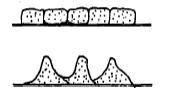 Each layer has to be cast before the former layer
has started setting.
Each layer has to be cast before the former layer
has started setting.
3.4.3 Casting concrete inside standing water
The depth of the water should not exceed 20 cm,
as this would demand a pump and a water tight
formwork.
The amount of cement has to be increased by at
least 50 kg/m3 finished concrete.
The concrete has to be consolidated immediately
after placing.
It is not possible to cast concrete inside flowing
water.
3.5 Consolidating concrete
3.5.1 Why consolidating ?
If concrete is simply poured into a form and left
to harden without further treatment, the product
will contain a number of defects:
- Large number of bubbles entrapped in the
material.
- Inadequate coverage of coarse aggregates.
- Small or intricate form spaces are not
completely filled.
- Reinforcing steel is not solidly bonded to
the concrete.
3.5.2 Hand - vibrated concrete
The concrete layers 'should -not be thicker than
15 to 20 centimeters. Those layers have to be
stamped vigorously especially at the edges and
the corners until the water rises up to the
surface.
If the work is interrupted for more than 2 hours,
the last layer has to be roughened before new
casting can go on.
3.5.3 Consolidating with vibrator
Proper consolidating is only possible with vibrators.
But these engines are heavy and
expensive. From the transportation point of view
therefore, it is not practical to use vibrators
in the hilly regions of Nepal.
3.6 Curing concrete
3.6.1 Drying out
As mentioned in the chapter on cement, concrete
hardens as a result of the hydration of the
cement by water. Fresh concrete contains more
than enough water to hydrate the cement completely,
but if the concrete is not protected against
drying out, the water, especially near the surface,
will drop below the amount required for complete
hydration.
3.6.2 Shrinkage
Rapid drying-out causes a decrease in volume,
which starts at the surface of the concrete
mass while the centre of the mass is still
wet. This causes a surface tension which the
fresh concrete is not able to absorb, The
results are reticular cracks all over the surface.
The more water and cement are used the more the
concrete shrinks.
3.6.3 Curing
The procedure called curing is designed to prevent
surface evaporation of water during setting and
hardening stages.
Curing starts as soon as possible without damaging
the surface. Curing is brought about
by keeping the concrete surface continuously
wet. Depending upon the structure and the means
available this may be done by:
- Sprinkling or flooding
- Covering with jute bags, grass and leaves
which should be wet continuously. Min.
coverage 5 cm.
Highly strained concrete should be kept moist for
at least 14 days.
3.7 Removal of forms
Forms should be left in place until the concrete has
hardened enough to hold its own weight and any other
weight it may be carrying.
The surface must be hard enough to remain uninjured and
unmarked when care is used in stripping the forms. The
engineer in charge of the project should tell how long
the formwork should remain in place.